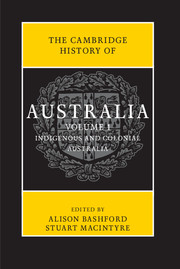Book contents
- Frontmatter
- Contents
- Abbreviations
- List of maps
- List of figures
- List of tables
- Notes on contributors
- Map
- Preface
- Introduction
- PART I
- 1 The past 50,000 years: an archaeological view
- 2 Newcomers, c. 1600–1800
- 3 Convict transportation in global context, c. 1700–88
- 4 The early colonial presence, 1788–1822
- 5 Expansion, 1820–50
- 6 The advent of self-government, 1840s–90
- 7 The gold rushes of the 1850s
- 8 Colonial states and civil society, 1860–90
- 9 Rethinking the 1890s
- 10 Making the federal Commonwealth, 1890–1901
- PART II
- Further reading
- Chronology
- Index
- Frontmatter
- Contents
- Abbreviations
- List of maps
- List of figures
- List of tables
- Notes on contributors
- Map
- Preface
- Introduction
- PART I
- PART II
- Further reading
- Chronology
- Index
4 - The early colonial presence, 1788–1822
from PART I
Published online by Cambridge University Press: 05 November 2013
- Frontmatter
- Contents
- Abbreviations
- List of maps
- List of figures
- List of tables
- Notes on contributors
- Map
- Preface
- Introduction
- PART I
- 1 The past 50,000 years: an archaeological view
- 2 Newcomers, c. 1600–1800
- 3 Convict transportation in global context, c. 1700–88
- 4 The early colonial presence, 1788–1822
- 5 Expansion, 1820–50
- 6 The advent of self-government, 1840s–90
- 7 The gold rushes of the 1850s
- 8 Colonial states and civil society, 1860–90
- 9 Rethinking the 1890s
- 10 Making the federal Commonwealth, 1890–1901
- PART II
- Further reading
- Chronology
- Index
- Frontmatter
- Contents
- Abbreviations
- List of maps
- List of figures
- List of tables
- Notes on contributors
- Map
- Preface
- Introduction
- PART I
- PART II
- Further reading
- Chronology
- Index
Summary
The arrival of the ‘First Fleet’ in Botany Bay in 1788 marked the birth of modern Australia. The governor, 550 officers and marines and 736 settler-convicts (188 women, 548 men, along with around 25 children of convicts) who came ashore in January and February that year were not the first settlers of the continent. But the settlement they founded at Sydney Cove was the starting point for early colonial expansion, and ultimately created the social and economic foundations of the nation.
This great migration also marked the beginning of what historian Alan Frost calls ‘the most striking penal experiment in history’. The settlers of 1788 were there to found an unusual colony: one designed explicitly for the reform and resettlement of convicts. The British government envisaged a subsistence agricultural colony that would transform felons into farmers. It was to be a new society, not a gaol. The long-term role of the colony was less clear, perhaps deliberately so. But at the outset Governor Phillip's Instructions were unambiguous: convicts would initially work on large public farms, growing ‘food from a common industry’ to replace the rations that would run out after two years. Once free, men were eligible for small land grants: 30 acres for a man, 20 more for a wife and ten for each child, with tools, seed grain and rations for two years. Women were integral to the scheme from the start, though as helpmeets rather than subjects in their own right. Men and women, reformed by hard, simple agricultural work, would eventually become small landowners. Land was the lynchpin of the scheme. It would succour them, anchor them: it was the basis of a new society.
By contrast, Phillip had no instructions at all on urban development, nor any real economic plan, apart from some vague hopes of producing raw materials for England.
- Type
- Chapter
- Information
- The Cambridge History of Australia , pp. 91 - 120Publisher: Cambridge University PressPrint publication year: 2013
- 5
- Cited by



